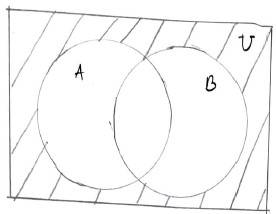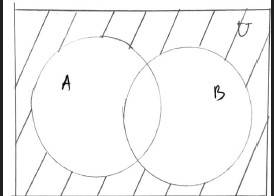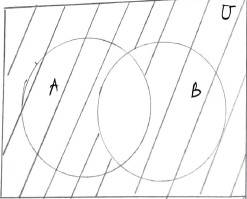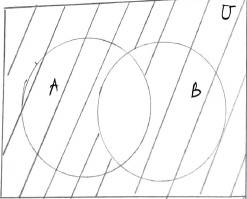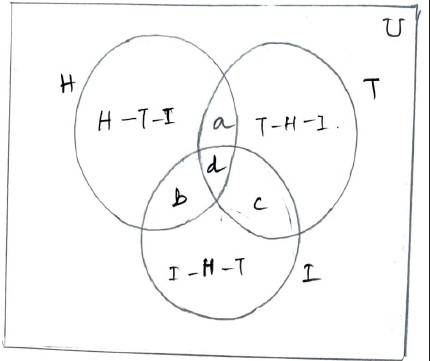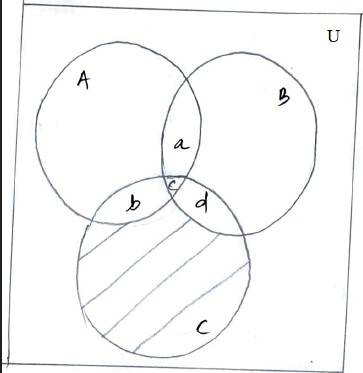
Class 11 Chapter 1 Sets NCERT Solutions: Students can access complete NCERT solutions for Class 11 Chapter 1 Sets prepared by our experts in Shiksha. Class 11 Sets have a good weightage in annual exams and combined with Relation and Function it's also important in competitive exams such as JEE Mains and others. Class 11 Math Sets delve into topics such as Fundamentals, Types, Finites & Infinite Sets, Venn Diagrams, and operations on set.
Class 11 Math Sets NCERT Solutions will be very useful for both board and entrance exam students and We have designed the solutions in such a way that concepts are easy to understand. Shiksha has prepared complete class 11 Sets NCERT Solutions by our experts to help students. Students can access the complete Exercise-wise NCERT Class 11 Chapter 11 Sets Solution PDF through the link below.
Students can use the NCERT Solutions of Sets Class 11 Math textbook to strengthen their concepts for CBSE Boards as well as other Entrance exams such as JEE Main, CUSAT CAT, etc. Students must check Class 11 Mathematics topics such as Relation and Functions, and Permutation and combination for more inclusive understanding. The German mathematician Georg Cantor developed the theory of sets. A set is a well-defined collection of objects. A set that does not have any element is defined as an empty set. A set that consists of a definite number of elements is called a finite set, otherwise, the set is called an infinite set
Students also check the Class 11 Sets NCERT solutions, which can help to get a better understanding of several other chapters in mathematics. Students can access the complete Class 11 Math chapter-wise Solutions and Class 12 Chapter-wise Math solutions on Shiksha. For more information check below;
| Class 11 Math-Related Chapter Solutions | ||
|---|---|---|
| Class 11 Chapter 2 Relation and Function | Class 11 Chapter 3 Trigonometric Functions | Class 11 Chapter 5 Linear Inequalities |
- Class 11 Chapter 1 Sets: Key Topics, Weightage and Important formulae
- Class 11 Chapter 1 Sets NCERT Solution PDF: Free PDF Download
- Class 11 Chapter 1 Sets Exercise-wise NCERT Solutions
- Class 11 Chapter 1 Sets Exercise 1.1 Solutions
- Class 11 Chapter 1 Sets Exercise 1.2 Solutions
- Class 11 Chapter 1 Sets Exercise 1.3 Solutions
- Class 11 Chapter 1 Sets Exercise 1.4 Solutions
- Class 11 Chapter 1 Sets Exercise 1.5 Solutions
- Class 11 Chapter 1 Sets Exercise 1.6 Solutions
- Class 11 Chapter 1 Sets Miscellaneous Exercise NCERT Solutions
- Mathematics Prep Tips and Recommended Books for Boards and Competitive Exams
Class 11 Chapter 1 Sets: Key Topics, Weightage and Important formulae
Class 11th Math Sets chapter carries around 6-8 marks weightage in the annual exams. Class 11 Sets chapter is also important to develop a basic understanding of Relation and Function, their formation, domain, and ranges. Sets combined with Relation and Function are also important for JEE Mains. Several key issues are discussed in the exercises;
Class 11 Math Sets Key Topics
- Basic Concepts of Sets: Definition and Representation of Sets (Roster & Set Builder Form)
- Types of Sets: Finite, Infinite, Equal, Null, Singleton, Universal, etc.
- Operations on Sets: Union, Intersection, Difference, Complement of a Set
- Venn Diagrams: Representation, and Solving Problems using Venn Diagrams
- Subsets and Power Sets
- Algebra of Sets: Idempotent Law, Domination Law, Commutative Law, Associative Law, Distributive Law, De Morgan’s Laws, Cartesian Product of Sets
- Ordered Pairs: Cartesian Product, Number of Elements in A × B (|A × B| = |A| × |B|)
Check out the Dropped Topics for Sets – 1.7 Power Set, Exercise 1.3 Ques. 5, 1.12 Practical Problems on Union and Intersection of Two Sets(Exercise 1.6), Examples 31–34 and Ques. 6–7 & Ques. 13–16 (Miscellaneous Exercise)
Class 11th Important Formulae
-
Number of Elements Formula
-
De Morgan’s Laws
-
Subset Formula
- Total subsets of a set with ‘n’ elements =
- Total proper subsets =
-
Properties of Union and Intersection
- (Commutative Property)
- (Commutative Property)
- (Associative Property)
- (Associative Property)
Class 11 Chapter 1 Sets NCERT Solution PDF: Free PDF Download
Students can find the solutions to all the exercises of class 11 Math Sets in one place. This Class 11 Chapter 1 Sets NCERT solution PDF is a very useful document for all categories of students whether on boards or competitive exams such as JEE Mains, BITSAT and others. access the Sets NCERT solution PDF below;
Class 11 Math Chapter 1 Sets NCERT Solution: Free PDF Download
Explore exams which ask questions on Maths Ncert Solutions class 11th
Select your preferred stream
Class 11 Chapter 1 Sets Exercise-wise NCERT Solutions
Class 11 Sets chapter deals with many important topics, such as the definition and representation of Sets, and types of Sets; Finite, Infinite, Singleton, Universal, etc., Venn Diagrams, operations on sets. . Students will encounter problems related to different concepts and properties of Set Theory in these exercises. Candidates can check the exercise-wise Chapter 1 Class 11 math solutions below;
Class 11 Chapter 1 Sets Exercise 1.1 Solutions
Class 11 Chapter 1 Sets Exercise 1.1 focuses on building the basic conceptual understanding of Set, relation and function. Sets Exercise 1.1 deals with fundamental concepts such as the representation of sets (roster form and set-builder form), types of sets (finite, infinite, empty, equal, and equivalent sets), and Venn diagrams. the Class 11 Set Exercise 1.1 also focuses on operations on sets like union, intersection, and complement of sets. Exercise 1.1 Solutions includes a total of 6 Questions all descriptive. Students can check the complete solution of Exercise 1.1 Below:
Class 11 Chapter 1 Set Exercise 1.1 NCERT Solutions
Q1. Which of the following are sets? Justify your answer.
(i)The collection of all the months of a year beginning with the letter J.
(ii)The collection of ten most talented writers of India.
(iii)A team of eleven best-cricket batsmen of the world.
(iv)The collection of all boys in your class.
(v)The collection of all natural numbers less than 100.
(vi)A collection of novels written by the writer Munshi Prem Chand.
(vii)The collection of all even integers.
(viii)The collection of questions in this Chapter.
(ix)A collection of most dangerous animals of the world.
A.1. (i)The collection of all months of a year with J as initial are January, June and July. Hence, it is a well-defined and is therefore a set .
(ii)The collection of ten most talented writers of India is not well-defined as it may vary from one person to another. Hence, it is not a set.
(iii)The team of 11 best-cricket batsmen of the world is not well-defined as it may vary from one parson to another as they may vary from one person to another. Hence, it is not a set.
(iv)The collection of all boys in your class is well-defined as your-class is fixed. Hence, it is a set.
(v)The collection of all natural numbersless than 100 will be from 1 to 99. Hence, it is well-defined and is therefore a set.
(vi)Novels written by writer Munshi Prem cham is a well-defined collection as he is no more so. Hence it is a set.
(vii)The collection of all even integers is well-defined and hence is a set.
(viii)The collection of questions in this chapter is well-defined and hence is a set.
(ix)The collection of most dangerous animals of the world is not well-defined as it may vary from one person to another.
Q2. Let A = {1, 2, 3, 4, 5, 6}. Insert the appropriate symbol or in the blank spaces:
(i)5. . .A(ii)8 . . . A (iii)0. . .A
(iv) 4. . . A (v) 2. . .A (vi) 10. . .A
A.2. (i)5 A(ii)8 A(iii)0 A
(iv)4 A(v)2 A(vi)10 A
Q3. Write the following sets in roster form:
(i)A = {x : x is an integer and –3< x < 7}
(ii) B = {x : x is a natural number less than 6}
(iii) C = {x : x is a two-digit natural number such that the sum of its digits is 8}
(iv) D = {x : x is a prime number which is divisor of 60}
(v) E = The set of all letters in the word TRIGONOMETRY
(vi) F = The set of all letters in the word BETTER
A.3. (i)A = {– 3, –2, –1, 0, 1, 2, 3, 4, 5, 6}
(ii)B = {1, 2, 3, 4, 5}
(iii)C = {17, 26, 35, 44, 53, 62, 71, 80}
(iv)x = Prime number which are divisor of 60
Factors of 60 are 1,2,3,4,5,6,10,12,15,20,30,60
Hence, x = 2, 3, 5
⸫D = {2, 3, 5}
(v) E = {T, R, I, G, O, N, M, E, Y}
(vi) F = {B, E, T, R}
Q4. Write the following sets in the set-builder form:
(i)(3, 6, 9, 12} (ii) {2,4,8,16,32} (iii) {5, 25, 125, 625}
(iv) {2, 4, 6, . . .} (v) {1,4,9, . . .,100}
A.4. (i) {3,6,9,12}={3 × 1, 3 × 2, 3 × 3, 3 × 4}
= {x : x = 3n, n is natural number and 1≤ n ≤ 4}
(ii){2,4,8,16,32}={21, 22, 23, 24, 25}
={x : x = 2n, n is natural number and 1 ≤ n ≤ 5}
(iii){5,25,125,625}={51, 52, 53, 54}
={x : x = 5n, n is natural number and 1 ≤ n ≤ 4}
(iv){2,4,6,}={2 × 1, 2 × 2, 2 × 3, …}
={x : x = 2n, n is a natural number}
(v){1,4,9, …, 100}={12, 22, 32, …, 102}
= {x : x = n2, x is a natural number and 1 ≤ n ≤ 10}
Q5. List all the elements of the following sets :
(i)A = {x : x is an odd natural number}
(ii) B = {x : x is an integer,
(iii) C = {x : x is an integer, }
(iv)D = {x : x is a letter in the word “LOYAL”}
(v) E = {x : x is a month of a year not having 31 days}
(vi)F = {x : x is a consonant in the English alphabet which precedes k }.
A.5. (i)A = {1, 3, 5, 7, …}
(ii)B ={0,1,2,3,4} (as =4.5 and = –0.5)
(iii)x2 ≤ 4
x2 ≤ 22
x ≤ ± 2
So, C ={–2, –1,0,1,2}
(vi)D = {L, O, Y, A}
(v)E = {February, April, June, September, November}
(vi)F = {b, c, d, f, g, h, j}
Q6. Match each of the set on the left in the roster form with the same set on the right described in set-builder form:
(i){1, 2, 3, 6} (a) {x : x is a prime number and a divisor of 6}
(ii) {2, 3} (b) {x : x is an odd natural number less than 10}
(iii) {M,A,T,H,E,I,C,S} (c){x : x is natural number and divisor of 6}
(iv) {1, 3, 5, 7, 9} (d){x : x is a letter of the word MATHEMATICS}.
A.6. (i)(i) (c)
(ii) (a)
(iii) (d)
(iv) (b)
Class 11 Chapter 1 Sets Exercise 1.2 Solutions
Class 11 Chapter 1 Sets Exercise 1.2 introduces important operations and properties of Set Theory. This Exercise 1.2 focuses on subsets, power sets, universal sets, and Venn diagrams, which are key to understanding Set Theory. Exercise 1.2 of class 11 Sets also explores operations on sets, including union, intersection, difference, and complement of set. Class 11 Set Exercise 1.2 Solutions consists of answers to 6 Questions. Students can check the complete solution of Exercise 1.2 Below;
Class 11 Chapter 1 Set Ex 1.2 NCERT Solutions
Q1. Which of the following are examples of the null set
(i) Set of odd natural numbers divisible by 2
(ii) Set of even prime numbers
(iii) {x : x is a natural numbers, x < 5 and x > 7}
(iv) {y : y is a point common to any two parallel lines}
A.l. (i)There is no odd number that can be divided by 2.
⸫The given set is a null set.
(ii)An even prime number is 2. Hence, the set will have 2 as element. ⸫ The given set is not a null set.
(iii)As there is no natural number which is both less than 5 and greater than 7. ⸫ The given set is a null set.
(iv)Two parallel lines never meets and hence no common point. ⸫ The given set is a null set.
Q2. Which of the following sets are finite or infinite
(i) The set of months of a year
(ii) {1, 2, 3, . . .}
(iii) {1, 2, 3, . . ., 99, 100}
(iv) The set of positive integers greater than 100
(v) The set of prime numbers less than 99
A.2. (i)The set of months of a year has 12 elements. Here, the set is finite.
(ii)The given set has the natural number as its elements. Hence, the set is infinite.
(iii)The given set has 100 elements i.e., from 1 to 100. Hence, the set is finite.
(iv)There are infinite numbers of positive integers greater than 100. Hence the set is infinite.
(v)The numbers of prime number less than 99 is finite. Hence, the set is finite.
Q3. State whether each of the following set is finite or infinite:
(i) The set of lines which are parallel to the x-axis
(ii) The set of letters in the English alphabet
(iii) The set of numbers which are multiple of 5
(iv) The set of animals living on the earth
(v) The set of circles passing through the origin (0,0)
A.3. (i)We can draw infinite number of lines parallel to x-axis.
⸫The set is infinite.
(ii)There are 26 letters in the English alphabet.
⸫The set is finite.
(iii)There are infinite number which are a multiple of 5.
⸫The set is infinite
(iv)The numbers of animals living on earth are finite.
⸫The set is finite.
(v)There can be infinite number of circular passing through origin (0,0).
⸫The set is infinite.
Q4. In the following, state whether A = B or not:
(i) A = { a, b, c, d } B = { d, c, b, a }
(ii) A = { 4, 8, 12, 16 } B = { 8, 4, 16, 18}
(iii) A = {2, 4, 6, 8, 10} B = { x : x is positive even integer and x < 10}
(iv) A = { x : x is a multiple of 10}, B = { 10, 15, 20, 25, 30, . . . }
A.4. (i)As A and B has a, b, c and d as elements and are exactly the same, Hence, A = B.
(ii)Hence, 12 A but 12 B
Similarly 18 B but 18 A.
So, A ≠ B.
(iii)A = {2,4,6,8,10} and B = {2,4,6,8,10}
So, A=B.
(v)A={10,20,30,40, …} and B={10,15,20,25,30, …}
So, A ≠ B.
Q5. Are the following pair of sets equal? Give reasons.
(i) A = {2, 3}, B = {x : x is solution of x2+ 5x + 6 = 0}
(ii) A = { x : x is a letter in the word FOLLOW}
B = { y : y is a letter in the word WOLF}
A.5. (i)A = {2, 3)
B = {x : x is solution of x2 + 5x + 6 = 0}
So, x2 + 5x + 6 = 0
x2 + 2x + 3x + 6 = 0
x(x+2) + 3(x+2) = 0
(x+2)(x+3) = 0
x = –2, –3
So, B = {–2, –3}
So, A ≠ B.
(ii)A = {x : x is a letter in word FOLLOW}
A = {F, O, L, W}
B = {x : x is a letter in word WOLF}
B = {W, O, L, F}
So, A = B as the elements are all same.
Q6.From the sets given below, select equal sets :
A = { 2, 4, 8, 12}, B = { 1, 2, 3, 4}, C = { 4, 8, 12, 14}, D = { 3, 1, 4, 2}
E = {–1, 1}, F = { 0, a}, G = {1, –1}, H = { 0, 1}
A.6. B = D = {1, 2, 3, 4} = {3, 1, 4, 2}
E = G = {–1, 1} = {1, –1}.
Class 11 Chapter 1 Sets Exercise 1.3 Solutions
Class 11 Math Chapter 1 Sets Exercise 1.3 focuses on the algebra of sets, introducing important properties and identities that govern set operations. This section explores laws of union and intersection, such as commutative, associative, and distributive laws, which help simplify complex set expressions. Additionally, it covers De Morgan’s Laws, which provide a systematic way to find the complement of set operations.
Exercise 1.3 Solutions 9 Questions
Students can check the complete solution of Exercise 1.3 Below
Class 11 Set Exercise 1.3 Solutions
Q1. Make correct statements by filling in the symbols or ₡ in the blank spaces :
(i) { 2, 3, 4 } . . . { 1, 2, 3, 4,5 } (ii) { a, b, c } . . . { b, c, d }
(iii) {x : x is a student of Class XI of your school}. . .{x : x student of your school}
(iv) {x : x is a circle in the plane} . . .{x : x is a circle in the same plane with radius 1 unit}
(v) {x : x is a triangle in a plane} . . . {x : x is a rectangle in the plane}
(vi) {x : x is an equilateral triangle in a plane} . . . {x : x is a triangle in the same plane}
(vii) {x : x is an even natural number} . . . {x : x is an integer}
A.1. (i){2,3,4} {1,2,3,4,5}
(ii){a, b, c} ₡ {b, c, d}
(iii){x : x is a student of class XI of yours school} {x : x is a student of your school}
(iv)As any circle in the plane can have radius more or less than 1 unit.
(x : x is a circle in the plane) ₡ {x : x is a circle in the same plane with radius 1 unit}
(v)As a triangle can never be a rectangle.
{x : x is a triangle in a plane} ₡ {x : x is a triangle in the same plane}
(vi)Any triangle in a plane can be scaler, isosceles, equilateral.
So. {x : x is a equilateral triangle in a plane} {x : x is a triangle in the same plane}
(vii)As all even natural number is also an integer.
{x : x is an even natural number} {x : x is an integer}.
Q2. Examine whether the following statements are true or false:
(i) { a, b } ₡ { b, c, a }
(ii) { a, e } { x : x is a vowel in the English alphabet}
(iii) { 1, 2, 3 } { 1, 3, 5 }
(iv) { a } { a, b, c }
(v) { a } { a, b, c }
(vi) { x : x is an even natural number less than 6} { x : x is a natural number which divides 36}
A.2. (i)False as every element of set {a, b} is also an element of {b, c, a} hence {a, b } { b, c, a }.
(ii)True as every element in {a, e} is also a vowel in English alphabet.
(iii)False as 2 {1, 2, 3} but 2 {1, 3, 5}.
(iv)True as a {a} is also a {a, b, c}
(v)False as a {a, b, c} but {a} {a, b, c}
(vi){x : x is an even natural number less than 6} = {2, 4}
{x : x is a natural number which divides 36} = {1, 2, 3, 4, 6, 9, 12, 18, 36}
As {2, 4} {1, 2, 3, 4, 6, 9, 12, 18, 36}
It is true.
Q.3. Let A = { 1, 2, { 3, 4 }, 5 }. Which of the following statements are incorrect and why?
(i) {3, 4} A (ii) {3, 4} A (iii) {{3, 4}} A
(iv) 1 A (v) 1 A (vi) {1, 2, 5} A
(vii) {1, 2, 5} A (viii) {1, 2, 3} A (ix) A
(x) A (xi) { } A
A.3. (i)False as 3 A and 4 4. So, {3, 4} A.
(ii)True as {3, 4} A. i.e, {3, 4} is an element of A.
(iii)True as {3, 4} A so, {3, 4} A.
(iv)True as 1 is an element of A.
(v)False as 1 is not a set so it cannot be a subset of A.
(vi)True as 1 A, 2 A and 5 A. so, {1, 2, 5} A.
(vii)False as {1, 2, 5} is not an element of A.
(viii)False of 3 A.
(ix)False as is not an element of A.
(x)True, ⸦ A as is a subset of every set.
(xi)False, as is not an element of A.
Q4. Write down all the subsets of the following sets
(i) {a}(ii) {a, b}(iii) {1, 2, 3} (iv)
A.4. (i)Subset of {a} = {a}, .
(ii)Subset of {a, b} = ,{a},{b},{a, b}
(iii)Subset of {1,2,3} = ,{1},{2},{3}, {1,2}, {1,3}, {2,3}, {1,2,3}.
(iv)Subset of = .
Q5. How many elements has P(A), if A = ?
A.5. As A= , no elements
n(A) = 0 = m
So, n[P(A)] = 2m = 20 = 1.
Q6. Write the following as intervals:
(i) {x : x R, – 4 <x < 6} (ii) {x : x R, – 12 < x < –10}
(iii) {x : x R, 0 x < 7} (iv) {x : x R, 3 x 4}
A.6. (i)As x does not include –4 while 6 is included.
(–4, 6].
(ii)As x does not include both –12 and –10.
(–12, –10)
(iii)As x includes 0 but does not includes 7.
[0, 7)
(iv)As includes both 3 and 4
[3, 4]
Q7. Write the following intervals in set-builder form :
(i) (– 3, 0) (ii) [6 , 12] (iii) (6, 12] (iv) [–23, 5)
A.7. (i)[–3, 0] = {x : x such that x R, –3 < x <0}
(ii)[6, 12] = {x : x R, 6 ≤ x ≤ 12}
(iii)(6, 12] = {x : x R, 6 < x ≤ 12}
(iv)[–23, 5) = {x : x R, –23 ≤ x < 5}
Q8. What universal set(s) would you propose for each of the following:
(i)The set of right triangles. (ii) The set of isosceles triangles.
A.8. (i)The set of all triangles. U= {x : x is a triangle in a plane}
(ii) The set of all triangles. U= {x : x is a triangle in a plane}
Q9. Given the sets A = {1, 3, 5}, B = {2, 4, 6} and C = {0, 2, 4, 6, 8}, which of the following may be considered as universal set (s) for all the three sets A, B and C
(i) {0, 1, 2, 3, 4, 5, 6}
(ii)
(iii) {0,1,2,3,4,5,6,7,8,9,10}
(iv) {1,2,3,4,5,6,7,8}
A.9. Universal set of A, B and C must includes all elements of A, B and C, i.e. 0,1,2,3,4,5,6,8.
So, the universal set of A, B and C is (iii) {0,1,2,3,4,5,6,7,8,9,10}.
Class 11 Chapter 1 Sets Exercise 1.4 Solutions
Class 11 Chapter 1 Sets Exercise 1.4 focuses on the practical applications of set theory, particularly in solving problems using the principle of inclusion and exclusion. Class 11 Math Exercise 1.4 is very important to understand counting elements in unions and intersections of multiple sets efficiently. Many important concepts such as finite and infinite sets, cardinality of sets, and methods to determine the number of elements in given set operations are discussed in Exercise 1.4 of Class 11 Sets. Class 11 Sets Exercise 1.4 consists of 12 questions. Students can check solutions to all 12 questions in Exercise 1.4 Below.
Sets Ex 1.4 Class 11 Math Solutions
Q1. Find the union of each of the following pairs of sets:
(i) X = {1, 3, 5} Y = {1, 2, 3}
(ii) A = [ a, e, i, o, u} B = {a, b, c}
(iii) A = {x : x is a natural number and multiple of 3}
B = {x : x is a natural number less than 6}
(iv) A = {x : x is a natural number and 1 < x 6 }
B = {x : x is a natural number and 6 < x <10 }
(v) A = {1, 2, 3}, B =
A.1. (i)X∪ Y = {1,3,5}∪ {1,2,3} = {1,2,3,5}.
(ii)A ∪B = {a, e, i, o, u} ∪{a, b, c} = {a, b, c, e, i, o, u}
(iii)A = {3, 6, 9, 12 …}
B = {1, 2, 3, 4, 5}
So, A∪ B = {3, 6, 9, 12, …}∪ {1, 2, 3, 4, 5}
= {1, 2, 3, 4, 5, 6, 9, 12 …}
(iv)A = {2, 3, 4, 5, 6}
B = {7, 8, 9}
So, A∪ B = {2, 3, 4, 5, 6}∪ {7, 8, 9} = {2, 3, 4, 5, 6, 7, 8, 9}
(v)A ∪B = {1, 2, 3} ∪ = {1, 2, 3}.
Q2. Let A = { a, b }, B = { a, b, c}. Is A B ? What is A B ?
A.2. Given,A = {a, b}
B = {a, b, c}
Yes A B as a, b A and a, b B.
And A B = {a, b} {a, b, c} = {a, b, c} = B
Q3.If A and B are two sets such that A B, then what is A B ?
A.3.If A ⸦ B then let a A and also a B.
but b B and b A i.e, A = {a} and B = {a, b}
So, A B = {x : x A or x B}
= {a, b}
= B
Q4. If A = {1, 2, 3, 4}, B = {3, 4, 5, 6}, C = {5, 6, 7, 8 } and D = { 7, 8, 9, 10 }; find
(i) A B (ii) A C (iii) B C (iv) B D
(v) A B C (vi) A B D (vii) B C D
A.4. (i)A B = {1, 2, 3, 4} {3, 4, 5, 6}
= {1, 2, 3, 4, 5, 6}
(ii)A C = {1, 2, 3, 4} {5, 6, 7, 8}
= {1, 2, 3, 4, 5, 6, 7, 8}
(iii)B C = {3, 4, 5, 6} {5, 6, 7, 8}
= {3, 4, 5, 6, 7, 8}
(iv)B D = {3, 4, 5, 6} {7, 8, 9, 10}
= {3, 4, 5, 6, 7, 8, 9, 10}
(v)A B C = (A B) C = {1,2,3,4,5,6} {5,6,7,8}
= {1, 2, 3, 4, 5, 6, 7, 8}
(vi)A B D = (A B) D = {1,2,3,4,5,6} {7,8,9,10}
= {1, 2, 3, 4, 5, 6, 7, 8, 9, 10}
(vii)B C D = (B C) D = {3,4,5,6,7,8} {7,8,9,10}
= {3, 4, 5, 6, 7, 8, 9, 10}
Q5. Find the intersection of each pair of sets of question 1 above.
A.5. (i)X ∩ Y = {1,3,5} ∩ {1,2,3} = {1,3}
(ii)A = {a, e, i, o, u} ∩ {a, b, c} = {a}
(iii)A ∩ B = {3,6,9,12 …} ∩ {1,2,3,4,5}
= {3}
(iv)A ∩ B = {2,3,4,5,6} ∩ {7,8,9} =
(v)A ∩ B = {1,2,3} ∩ =
Q6. If A = { 3, 5, 7, 9, 11 }, B = {7, 9, 11, 13}, C = {11, 13, 15}and D = {15, 17}; find
(i) A B(ii)B C (iii) A C D
(iv) A C (v) B D (vi) A (B C)
(vii) A D (viii) A (B D) (ix)(A B) (B C )
(x) (A D) (B C)
A.6. (i)A ∩ B = {3,5,7,9,11} ∩ {7,9,11,13}
= {7, 9, 11}
(ii)B ∩ C = {7,9,11,13} ∩ {11,13,15}
= {11,13}
(iii)A ∩ C ∩ D = (A ∩ C) ∩ D
= [{3,5,7,9,11} ∩ {11,13,15}] ∩ {15,17}.
= {11} ∩ {15,17} = .
(iv)A ∩ C = {3,5,7,9,11} ∩ {11,13,15}.
= {11}
(v)B ∩ D = {7,9,11,13} ∩ {15,17}=
(vi)A ∩ (B∪ C) = {3,5,7,9,11} ∩ [{7,9,11,13}∪ {11,13,15}]
= {3,5,7,9,11} ∩ {7,9,11,13,15}.
= {7,9,11}
(vii)A ∩ D = {3,5,7,9,11} ∩ {15,17} = .
(viii)A ∩ (B ∪ D) = {3,5,7,9,11} ∩ [{7,9,11,13} ∪ {15,17}]
= {3,5,7,9,11} ∩ {7,9,11,13,15,17}
= {7,9,11}
(ix)(A ∩ B) ∩ (B ∪ C) = [{3,5,7,9,11} ∩{7,9,11,13}] ∩ [{7,9,11, 13} ∪ {11,13, 15}]
= {7,9,11} ∩ {7,9,11,13,15}
= {7,9,11}.
(x)(A ∪ D) ∩ (B ∪ C) = [{3,5,7,9,11} ∪ {15,17}] ∩ [{7, 9, 11, 13} ∪ {11, 13, 15}
={3,5,7,9,11,15,17} ∩ {7,9,11,13,15}
={7,9,11,15}.
Q7. If A = {x : x is a natural number }, B = {x : x is an even natural number}
C = {x : x is an odd natural number} and D = {x : x is a prime number }, find
A B (ii) A C (iii) A D
(iv) B C (v) B D (vi) C D
A.7. A = {1,2,3,4,5, 6, …}
B = {2,4,6, …}
C = {1,3,5, …}
D = {2,3,5, …,}
(i)A ∩ B = {1,2,3,4 …} ∩ {2,4,6, …} = {2,4,6 …} = B.
(ii)A ∩ C = {1,2,3,4, …} ∩ {1,3,5 …} = {1,3,5, …} = C.
(iii)B ∩ C = {2,4,6, …} ∩ {1,3,5, …} = .
(iv)B ∩ D = {2,4,6 …} ∩ {2,3,5 …} = {2}
(v)C ∩ D = {1,3,5, …} ∩ {2,3,5 …} = {3,5,7 …} = {x : x is odd prime number}
Q.8. Which of the following pairs of sets are disjoint
(i){1, 2, 3, 4} and {x : x is a natural number and }
(ii) {a, e, i, o, u } and { c, d, e, f }
(iii) {x : x is an even integer} and {x : x is an odd integer}
A.8. (i){1,2,3,4} ∩ {x : x is a natural number and 4 ≤ x ≤ 6}
{1, 2, 3, 4} ∩ {4, 5, 6}
{4} ≠∅
Hence, the given pair of set is not disjoint.
(ii){a, e, i, o, u} ∩ {c, d, e, f}
{e} ≠∅
Hence, the given pair of set is not disjoint.
(iii){x: x is an even integer} ∩ {x: x is are odd integer}.
=∅
As there is no integer which is both even and odd at the same time.
⸫ Given pair of set are disjoint.
Q9. If A = {3, 6, 9, 12, 15, 18, 21}, B = { 4, 8, 12, 16, 20},
C = {2, 4, 6, 8, 10, 12, 14, 16}, D = {5, 10, 15, 20}; find
(i) A – B (ii) A – C (iii) A – D (iv) B – A
(v) C – A (vi) D – A (vii) B – C (viii) B – D
(ix) C – B (x) D – B (xi) C – D (xii) D – C
A.9. (i)A – B = {3,6,9,12,15,18,21} – {4,8,12,16,20}
= {3,6,9,15,18,21}
(ii)A – C = {3,6,9,12,15,18,21} – {2,4,6,8,10,12,14,16}
= {3,9,15,18,21}
(iii)A – D = {3,6,9,12,15,18,21} – {5,10,15,20}
= {3,6,9,12,18,21}
(iv)B – A = {4,8,12,16,20} – {3,6,9,12,15,18,21}
= {4,8,16,20}
(v)C – A = {2,4,6,8,10,12,14,16} – {3,6,9,12,15,18,21}
= {2,4,8,10,14,16}
(vi)D – A = {5,10,15,20} – {3,6,9,12,15,18,21}
={5,10,20}
(vii)B – C={4,8,12,16,20} – {2,4,6,8,10,12,14,16}
={20}
(viii)B – D ={4,8,12,16,20} – {5,10,15,20}
= {4,8,12,16}
(ix)C – B = {2,4,6,8,10,12,14,16} – {4,8,12,16,20}
= {2,6,10,14}
(x)D – B = {5,10,15,20} – {4,8,12,16,20}
= {5,10,15}
(xi)C – D = {2,4,6,8,10,12,14,16} – {5,10,15,20}
= {2,4,6,8,12,14,16}
(xii)D – C = {5,10,15,20} – {2,4,6,8,10,12,14,16}
= {5,15,20}
Q10. If X= { a, b, c, d } and Y = { f, b, d, g}, find
(i)X – Y (ii)Y – X (iii) X ∩Y
A.10. (i)X – Y = {a, b, c, d} – (f, b, d, g}
= {a, c}
(ii) Y – X = {f, b, d, g} – {a, b, c, d}
= {f, g}
(iii)X ∩ Y = {a, b, c, d} ∩ {f, b, d, g}
= {b, d}.
Q11. If R is the set of real numbers and Q is the set of rational numbers, then what is R – Q?
A.11. R – Q = {x: x is a real number but not rational number}
= {x: x is an irrational number}
Since real number = rational number + irrational number
Q12. State whether each of the following statement is true or false. Justify your answer.
(i) {2, 3, 4, 5} and {3, 6} are disjoint sets.
(ii) {a, e, i, o, u} and {a, b, c, d}are disjoint sets.
(iii) {2, 6, 10, 14} and {3, 7, 11, 15} are disjoint sets.
(iv) {2, 6, 10} and {3, 7, 11} are disjoint sets.
A.12. (i)False, as {2,3,4,5} ∩ {3,6} = {3} ≠ .Hence sets are not disjoint.
(ii)False as {a, e, i, o, u} ∩ {a, b, c, d} = {a} ≠ Hence sets are not disjoint.
(iii)True as {2,6,10,14} ∩ {3,7,11,15} = . Hence sets are disjoint.
(iv)True as {2,6,10} ∩ {3,7,11}= . Hence sets are disjoint.
Class 11 Chapter 1 Sets Exercise 1.5 Solutions
Class 11 Chapter 1 Sets Exercise 1.6 Solutions
Class 11 Chapter 1 Sets Miscellaneous Exercise NCERT Solutions
Mathematics Prep Tips and Recommended Books for Boards and Competitive Exams
Maths Ncert Solutions class 11th Exam
Student Forum
Popular Courses After 12th
Exams accepted
CA FoundationExams accepted
ICSI ExamExams accepted
BHU UET | GLAET | GD Goenka TestBachelor of Business Administration & Bachelor of Law
Exams accepted
CLAT | LSAT India | AIBEExams accepted
IPMAT | NMIMS - NPAT | SET
Exams accepted
BHU UET | KUK Entrance Exam | JMI Entrance ExamBachelor of Design in Animation (BDes)
Exams accepted
UCEED | NIFT Entrance Exam | NID Entrance ExamBA LLB (Bachelor of Arts + Bachelor of Laws)
Exams accepted
CLAT | AILET | LSAT IndiaBachelor of Journalism & Mass Communication (BJMC)
Exams accepted
LUACMAT | SRMHCAT | GD Goenka Test

